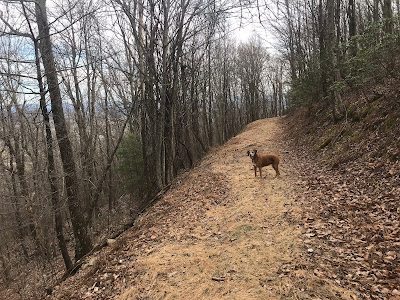Sugar Run Trail offers nice views and a big workout, climbing 2440 feet over a distance of 4.9 miles. The trail is also open to mountain bikers and equestrians, and is a popular route for bikers coming downhill at fast speeds. Be alert.
Vehicular access to either end of this trail is difficult:
- The eastern end is accessed via a rough jeep road (FR 85-4). Because there is no parking at the trail's end, this hike description will start where FR85-4 splits from FR 85. Even FR 85 is a tough drive after it leaves SR 924, Briery Branch Road, though I saw a driver in a Pontiac sedan navigating it.
- The western end is accessed via an unmarked side road off of Little Fork Road, which requires a stream ford before entering into National Forest land.
This hike description starts at the top of Shenandoah Mountain.
Mile 0.0: I parked just up the jeep road from where it splits off of FR 85. There is a large spot off of the road here, and a campsite another 50 feet up the jeep road that can be a vehicle turn-around. Walk north on the jeep road, reaching the hike's highest point a half mile up that road: 4170 feet elevation.
 |
| Parking spot on jeep road. FR 85 can be seen at the far end of the jeep road. |
 |
| Campsite just off of FR 85. Vehicles can turn around here. |
 |
| Visual evidence of why I would not drive the jeep road. |
Mile 0.7: Pass trailhead for Bother Ridge Trail, #1026. This is a shorter trail to the west that could be part of a long loop hike involving some road walks. To the right here is an unblazed trail that ascends to the summit of Bother Knob - at 4344 feet elevation, the site of a former fire tower. Also up there is the Shenandoah Mountain Trail, #1024, which continues north to the High Knob Fire Tower and U.S. 33 (Link).
 |
| Looking at Bother Ridge Trail from the jeep road. The Forest Service sign indicates hiking only, but Trails Illustrated map designates this trail as multi-use. |
Mile 0.8: Reach trailhead for Sugar Run Trail, marked with a metal trail sign indicating multi-use and starting out as an ungated woods road that drops away on the left from the jeep road. Follow the trail, leaving the jeep road.
Mile 1.2: The road ends at a spring with a small campsite next to it. It would appear that the road was created to access this spring. Passing this spot in late March, a large mass of salamander eggs are visible in the pool created by the spring.
 |
| Campsite along trail. Spring can be seen on the left. |
 |
| Salamander eggs. |
 |
| Sugar Grove Naval Radio Station seen through the pines. |
 |
| Steep Drop occurs after these rocks. |
Mile 3.8: The trail reaches an old road at 2140 feet elevation. Take note of where you are if you plan to return back this way: there is no trail sign here, and the point where the trail meets this road is marked only by a faded yellow blaze on a tree. Follow the road to the left, and shortly afterwards, you cross Sugar Run.
Mile 4.4: Cross a woods road. This road could be used for part of a circuit hike with the Bother Ridge Trail if followed to the left here. The Sugar Run Trail continues straight ahead through a gap in the trees and through a field.
 |
| Cross the road, then head straight into the field. |
 |
| Anticline seen along Sugar Run. |
Mile 5.0: Cross a stream and then come to a dirt road and two large campsites on the right. These are also parking areas for vehicles coming to the western trailhead from Little Fork Road. The trail technically ends here. Continuing down the road, you will encounter private property on both sides.
Mile 5.4: Reach Little Fork stream, just before the main access road. Vehicles driving up this road to park here will need to ford the stream. Turn around here.
 |
| Little Fork stream with the Little Fork Road a few feet up the hill on the other side. |
Mile 7.0: The trail leaves the woods road here. You will have just crossed Sugar Run and will see a level area that could be a great campsite on the left. Look carefully to your right for a faded yellow blaze signalling the trail's start up the ridge. As you start to climb, you may notice a deeply rutted track that heads straight up the mountain. This is not the trail - the trail climbs much more gradually along the side of the slope. It is damage created by mountain bikes going off trail.
 |
| Campsite, looking left from the road. Sugar Run is further left, over the small rise. |
 |
| Damage from mountain bikes is evident here. The actual trail climbs the side slope to the right. |
 |
| A faded yellow blaze and some compressed leaves subtly signal the trail leaving the woods road. |
Mile 10.1: Reach the jeep road again after gaining about 2150 feet from Sugar Run over the past 3 miles. Although the ascent is steep, winter views along the trail are nice. It may even be possible to see the High Knob Fire Tower during the ascent, using a small scope.







































